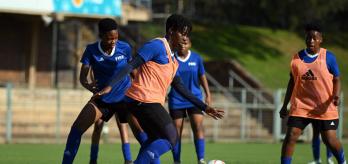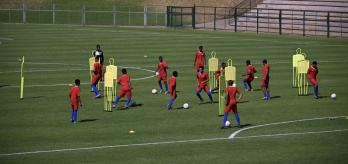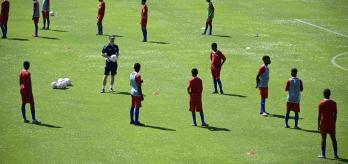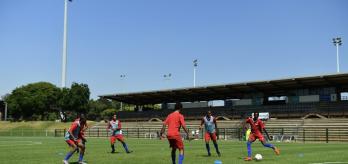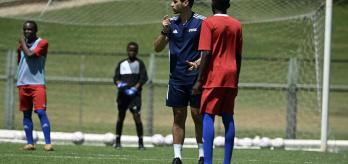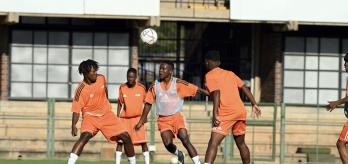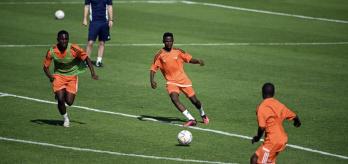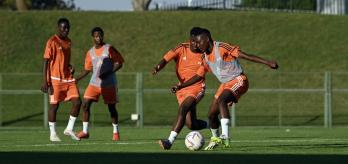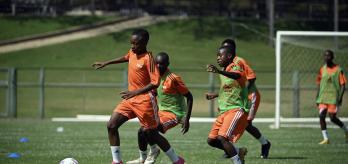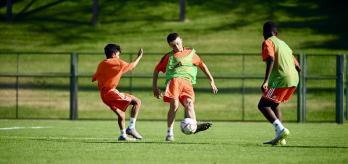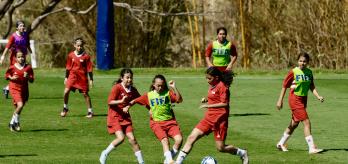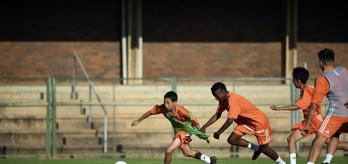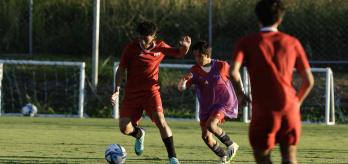Methodology
The intention: What is practised?
The objective of the exercises is to enhance a unit’s ability to build and progress play whilst prioritising playing forwards within a narrow focus. There are other aspects, such as creating and finishing, and denying and protecting, that do not feature in the exercises. The drills focus specifically on unit-level elements, such as quick combination play (between two or three players) to draw opponents in, off-the-ball movement that creates multiple passing lanes and support play to link with the central attacking player. The exercises simulate the build-up phase against a high-pressing team in which the attacking team are tasked with playing through or around the press by using centrally positioned players to eliminate opponents. In addition to unit skills, applying individual skills, such as disguised passes and body orientation, can help a unit to build play more effectively.
The scale: For whom is this relevant?
The exercises revolve around the unit and focus on off-the-ball movement and connecting with central players to progress play into attack. The drills allow a unit to develop its ability to play through the press by using a focal point in a central area. The exercises are particularly relevant to players who operate as a unit around and beyond the opposition’s first line of press. Wide players, such as full-backs, operate on the same line as the opposition’s press and can be used as support players. Meanwhile, inside the opposition’s shape, a midfielder (number 6) drops deep to try and receive the ball between the lines, and an attacker, such as a centre-forward, occupies a position between the two centre-backs to link up with and lay the ball off to a midfielder who has space in which to play. In addition to unit-level skills, effective movement to receive and retaining and protecting possession are important elements and narrow the focus on individual ability. Additionally, unit-level skills, such as pressing and regaining possession, are key when it comes to transitioning into defence/attack.
The practice type: How is the practice designed?
These exercises involve opposed possession games, featuring variable repetition that provides ample opportunities for a unit to practise offering to receive, retaining and protecting possession and movement to receive from an attacking perspective. From a defensive viewpoint, the exercises offer the unit the opportunity to work on intercepting, screening and blocking. Variations transpire to showcase different options when building and progressing play by using players in central areas when under intense pressure. The fact that the exercise is opposed requires the in-possession team to focus on decision-making and when to slow down and speed up play. The mannequins serve to provide visual orientation for players and simulate a defender’s positioning. The exercises are position-specific, with a goalkeeper or centre-back playing the ball out to full-backs, who are tasked with finding players operating inside the opposition’s shape.
Session plan
Organisation
-
Mark out two zones (Zone A and Zone B)
-
Zone A should be marked out by a 10x30m area with 2 mannequins 5m apart in the centre and have 8 players.
-
Zone B should be marked out by a 15x30m area with 2 mannequins 8m apart in the centre and have 10 players.
-
Each zone should have 3 teams, 2 teams play against each other and 1 takes a neutral role.
-
Zone A should have a 2v2 with 4 neutral players.
-
Zone B should have a 3v3 with 4 neutral players.
-
On each zone, position a neutral player at either end of the area, a neutral player between the mannequins and one neutral player to play freely.
Explanation
-
Play starts with a neutral player at one end of the exercise area in possession.
-
The in-possession team’s objective is to retain possession and move the ball from one end of the exercise area to the other with the help of the neutral players.
-
To score a point, the in-possession team must play through the central neutral player positioned between the mannequins.
-
The out-of-possession team try to recover possession.
-
If the out-of-possession team regain possession, in order to become the in-possession team, they have to play the ball to the neutral player positioned at the opposite end of the exercise area.
-
If the ball goes out of play, the coach introduces a new ball and play continues.
Variation
-
The neutral player positioned between the mannequins is limited to one touch.
Key coaching points
Roles of coaches
-
First coach: leads the exercise in exercise area B, where they intervene at intervals. They demonstrate areas of improvement when it comes to passing out of pressure and progressing possession.
-
Second coach: runs the exercise in exercise area A. They present players with various solutions to play out of pressure and encourage in-possession players to identify the right time to play forwards.
-
Third coach: observes both exercise areas and offers players encouragement.


























